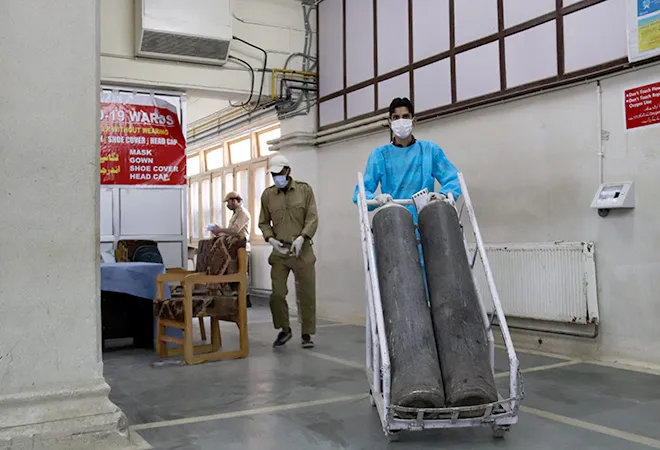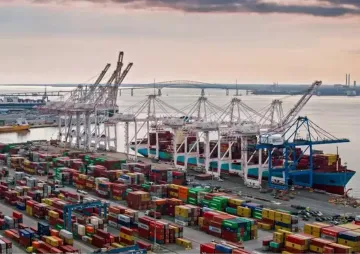
The second wave of COVID-19 exposed the world to India’s medical oxygen problem, as demand for the critical gas wasn’t met in many parts of the country, primarily due to issues in the supply chain. These issues, caused by poor delivery and connectivity systems, have reflected the status of India’s health infrastructure in the past too. In 2017, around 60 children succumbed to death in a week as multiple warnings about a possible disruption in oxygen supply were not paid heed to by a hospital in Gorakhpur, Uttar Pradesh. In Pune, a gap analysis of gas use in the Armed Forces Hospital in 2016 revealed a shoddy state of the delivery system, with major issues of pipeline maintenance and alarm mechanisms.
As highlighted by the Ministry of Health and Family Welfare (MoHFW) on April 15, India’s daily production capacity (7287 MT) was higher than the daily consumption, and it remained so for the rest of the wave too. The Empowered Group 2 (EG2) mapped sources of oxygen and prompted industries to divert their entire production. As claimed by the centre in an affidavit, the highest demand for medical oxygen came from states lying in the northern and western parts of the country, and the production had been largely centred in south-eastern states. This necessitated a massive logistics operation, which then unveiled more flaws in the supply chain.
Initially, the allocation of oxygen to different states, especially Delhi, remained a contention. The issue of shortage in supply was first raised on 19th April in the High Court of Delhi, when the Government of the National Capital Territory of Delhi (GNCTD) pointed out that they had already issued orders to divert industrial oxygen for medical use in the country. While the court had directed INOX to honour its contracts with hospitals in Delhi and ensure the supply of oxygen, it was alleged that the supply was diverted to other states. Two different reasons have been stated for the failure in the transportation of oxygen.
One, the number of cryogenic tankers available across the country was just 1224, and permission to convert another 1200 nitrogen and argon tankers was given much later. Until 26th April, the GNCTD was still under the process of importing cryogenic tankers, despite the MoHFW’s plea to the states to set up control rooms to ration the same.
Two, despite multiple claims by the Centre regarding the formation of a sub-group to facilitate the movement of tankers, companies like INOX and Air Liquide continued to face issues while moving such vehicles to other states. As stated by the Director of INOX in the Delhi High Court, four of their tankers were detained by the State of Rajasthan during a critical juncture.
More importantly, most hospitals in India are not equipped with the technology to store oxygen in its liquid form and, therefore, use cylinders to store it in its gaseous form. There was, however, no account being kept by the governments for the supply of cylinders to hospitals and nursing units. Until necessary intervention by the government, the supply of oxygen through cylinders remained an issue.
Most hospitals in India are not equipped with the technology to store oxygen in its liquid form and, therefore, use cylinders to store it in its gaseous form. There was, however, no account being kept by the governments for the supply of cylinders to hospitals and nursing units. Until necessary intervention by the government, the supply of oxygen through cylinders remained an issue
The Supreme Court, through suo moto action, prompted the Centre to make its stance clear on the matter. In response, the government filed a 218-page affidavit, claiming that logistical bottlenecks and local incidents disrupted the supply of oxygen. It also claimed to have conducted a mapping exercise to arrange a ‘judicious mix of road, rail, and air routes.’ However, states like Delhi continued to face shortages for many days after a strongly worded Supreme Court order had asked the Centre to remedy the situation.
Similar problems have been witnessed in other developing nations too. In Africa, Asia, and Latin America, the devastating combination of low vaccination rates and rising oxygen needs has made nations vulnerable. Moreover, as India banned its exports of liquid and cylinder oxygen during the second wave, neighbouring countries began to face a shortage, with countries like Nepal demanding 100 times more oxygen than they did in March. While some nations relied heavily on imports from bigger nations like India, others failed to divert industrial oxygen to medical use.
Lessons and suggestions
The United States and Western Europe relatively fared better at handling the crisis, with a sound medical-oxygen infrastructure built over decades. As such, these regions adopted measures to repurpose existing nonmedical supplies, such as industrial oxygen, and redistributed oxygen from underutilized healthcare facilities through better transportation. While countries like India suffered due to poor delivery systems in hospitals, these regions expanded systems like pipeline networks and vacuum-insulated evaporators at their hospitals. Vietnam too was better prepared, with about 250 tonnes per day medical oxygen available for a population of 62 million.
Before the pandemic, the Uttar Pradesh Health System Strengthening Project (UPHSSP) had released medical oxygen guidelines to improve oxygen therapy in the state. The document called for periodic assessment of the state’s oxygen supply system for all district-level hospitals, as well as the installation of piped medical gas system. A need for trained professionals to maintain such systems was also established.
With India recovering from the ramifications of the second wave and preparing for the third, there are a few things that can be done better. For one, better transportation should be made possible by increasing the fleet of cryogenic oxygen tankers; at the same time, existing production and distribution infrastructure should be improved to make the process economically efficient.
With India recovering from the ramifications of the second wave and preparing for the third, there are a few things that can be done better. For one, better transportation should be made possible by increasing the fleet of cryogenic oxygen tankers; at the same time, existing production and distribution infrastructure should be improved to make the process economically efficient.
The onshoring of production, by setting up PSA (Pressure swing adsorption) plants, is necessary to achieve this efficiency. This machinery would help hospitals manufacture oxygen and become self-reliant. A bid to install 162 such plants was delayed till January. As of April 18, only 33 plants out of 162 had been installed.
In the short run, however, acquiring and producing more oxygen concentrators is imperative, especially for smaller and far-flung regions with small hospitals where PSA plants cannot be set up and transportation is costly. Used extensively by hospitals in remote locations, concentrators can decrease reliance on dangerous cylinders and costly delivery mechanisms. However, a stable power supply is important for concentrators to function. In some low and middle-income countries, solar power has been used to solve the issue of electricity.
In the long run, production capacity must be monitored and increased. A handful of vendors in India are permitted to produce oxygen. As a result, the production process has been inflexible and concentrated in a few states of the country. To make the supply chain resilient, more such manufacturers should be allowed to enter the market in different states. Technological changes are also necessary for the future. Piped gas system must be installed in more hospitals, and the reliance on cylinders should be decreased to avoid wastage of the gas.
As the UPHSSP guidelines suggest, the supply and maintenance of oxygen should be monitored more effectively; at the district as well as the hospital level, the supply should be monitored to assess and forecast requirements and understand variations in demand. An alarm system along with a dedicated dashboard should be employed to monitor the supply.
Building a resilient supply chain of oxygen is important for a post-pandemic world as well. Oxygen is an important ingredient in treating several health conditions—ones that can cause greater worries for India’s health infrastructure.
The views expressed above belong to the author(s). ORF research and analyses now available on Telegram! Click here to access our curated content — blogs, longforms and interviews.




 PREV
PREV


